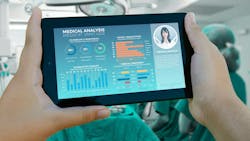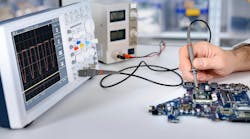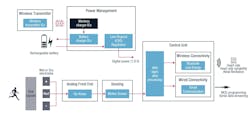What’s Next in Remote Monitoring for Digital Healthcare?
What you’ll learn:
- How chips combining motion and bio-signal sensing enable novel features in digital healthcare.
- What are the key applications for MEMS biosensors in the field of healthcare wearable devices.
Digital transformation puts the roles of the user and the patient at the center of the healthcare revolution. In digital healthcare, remote patient monitoring is intended to measure vital signs and other key parameters with non-invasive devices that wirelessly transmit patient information to their healthcare providers or other health stakeholders, while guaranteeing confidentiality (Fig. 1).
Monitoring of vital signs is the process of measuring and tracking important physiological parameters to assess the overall health and wellbeing of an individual. It’s paving the way to new opportunities for both wellness/fitness and medical applications, ranging from heart analysis, respiration rate, and oximetry to blood pressure and body temperature.
Nowadays, common practice is to sample periodic snapshots of vital signs by electrocardiograms, glycemia level, oximetry, and blood pressure through examinations using bulky devices. New technologies enable continuous measurement of the different health parameters to infer and predict malfunctions of organs/tissues and metabolic pathways.
The new technologies help healthcare providers detect and manage health conditions remotely. This can save time and costs as well as increase success in predicting and managing emergency cases. Use of medical-grade devices such as cardiac bands, electronic skin patches, and other wearable devices is increasing to accelerate de-hospitalization without compromising patient safety. This benefits national healthcare systems significantly by reducing costs while maintaining the high quality of healthcare services.
Smart watches and wrist bands, smart hearables and headsets, smart rings, fitness trackers, cardiac bands, and other wearable personal electronic devices embed new technologies for monitoring and improving user condition and performance. People can become aware of their health status in different contexts, and athletes' performance can improve since the devices provide insights into factors such as heart rate, hydration levels, and muscle activity (Fig. 2).
These wearable products represent a point of convergence of multiple technologies such as materials science, sensing and sensors, biosensors, electronics, microfluidics, and artificial intelligence. They’re revolutionizing the consumer healthcare segment by providing real-time monitoring and data collection in a non-invasive and convenient way.
Technical Challenges in Developing Remote Monitoring Systems
Beyond the well-known technical challenges such as ergonomics, user convenience, patient safety, data security, and connectivity, semiconductor manufacturers should address other critical aspects. Critical points are power consumption and battery life, big-data management, and medical reliability of extracted health indicators.
By addressing these critical points, the development of health monitoring technologies can lead to reliable, user-friendly, and medically approved devices that can play a significant role in preventive healthcare, chronic disease management, and overall health and wellness.
For instance, continuous monitoring of the heart—electrocardiography (ECG)—is a power-consuming process. It produces a large quantity of data that commonly needs to be managed, processed, and transmitted to the cloud for analysis. Moreover, the extracted data must be transmitted back to the wearable device for advising or alerting the user.
All of these factors represent technical challenges that the semiconductor industry needs to address to ensure devices’ on-field efficacy and deliver satisfactory user experiences.
Semiconductor and Biosensor Solutions for Healthcare Wearables
A variety of medical and consumer biosensors is now available to enable the design of wearable devices. Most of these sensors come with analog front-end components to simplify signal conditioning. However, they’re usually driven by an external microcontroller to perform data processing and health-indicator extraction. System complexity increases with the incremental use of multiple sensors for deducing more health-related outcomes.
STMicroelectronics (ST) is approaching this market with a new family of biosensors that offer on-chip analog sensing, the vertical analog front-end (vAFE) for ECG and electroneurography (ENG), a highly sensitive motion sensor (accelerometer and gyroscope) for seismocardiography (SCG), analog-to-digital conversion, features for human-body motion tracking, and embedded digital processing with artificial-intelligence resources that offload the microcontroller.
These unique semiconductor chips combine motion and bio-signal sensing in one device. They create multipurpose platforms where, for instance, ECG signals can be extracted and processed for computing heart rate and heart-rate variability, SCG signals can be extracted for computing the diastolic and systolic period to verify the opening and closure of the aortic and mitral valves (valvular heart-disease detection), and where both ECG and SCG signals can be processed for deriving further health indicators with the great advantage of full time synchronization. In other applications, ENG signals can be used for cognitive-readiness analysis, e.g., for athletes after concussion.
ST’s new biosensors, exploiting the integration of motion and bio-signal sensing, can enable novel features such as motion-artifact compensation and context-aware bio-signal measurements. The latter is valuable for increasing battery life since the biosensor understands the user context and activity, and the system can thus adapt the bio-signal acquisition setting and frequency accordingly.
ST MEMS biosensors are helping enable the following applications in the field of healthcare wearable devices:
- Home monitoring: ECGs and SCGs can be used by individuals to monitor their heart health at home. This can help identify potential problems early on and seek medical attention if necessary.
- Activity tracking: ECGs and SCGs can track heart-rate variability (HRV), which is a measure of how well the heart responds to stress. HRV can be used to assess overall health and fitness, as well as to detect early signs of stress and anxiety.
- Athletic training: ECGs and SCGs can monitor athletes' heart health during training and competition. This helps prevent overtraining and identifies potential cardiovascular problems. In addition, ENGs can monitor the readiness to play sports again after a trauma event like concussion.
- Remote patient monitoring and telehealth: ECGs and SCGs can be used for telehealth appointments, allowing patients to have their ECGs taken remotely by a healthcare provider.
Future Trends in Remote Monitoring Systems
Recent studies1,2 have demonstrated how the combination of these two sensing channels, ECG and SCG, can enable the indirect measurement of blood pressure. Further, more connectivity functionalities are able to be added, such as NFC, NB-IoT, and secure connections. On that front, ST offers low-power and high-performance STM32 microcontrollers, high-precision operational amplifiers, and a variety of AC-DC and DC-DC power-management and supply ICs, in addition to wireless-connectivity solutions.
In the semiconductor industry, there’s a growing trend toward developing more sophisticated biosensors. These sensors are specialized in detecting and measuring vital human-body analytes, including glucose, sodium, lactate, and calcium. Such advances are significant for healthcare, as they promise to enable continuous monitoring of these analytes in a less invasive way, which is essential for managing various health conditions and improving patient outcomes.
The semiconductor sector is also seeing investment and research efforts directed toward the next generation of low-power sensors that can continuously monitor human body temperature, which is a critical vital sign. The development of such technology is part of a broader initiative to enhance sensor portfolios for health and wellness applications, enabling more comprehensive and non-invasive monitoring of vital signs.
References
1. B. Kizir and B. Semiz, “Unveiling the Temporal and Spectral Relationships between Seismocardiogram Signals, Systolic Time Intervals and Thorax Characteristics,” 2023 5th International Conference on Bio-engineering for Smart Technologies (BioSMART), Paris, France, 2023, pp. 1-4, doi: 10.1109/BioSMART58455.2023.10162053.
2. Rai, D., Thakkar, H.K., Rajput, S.S., Santamaria, J., Bhatt, C., Roca, F. A, “Comprehensive Review on Seismocardiogram: Current Advancements on Acquisition, Annotation, and Applications,” Mathematics, 2021, 9, 2243.
About the Author

Enrico Alessi
Research and Development Application Manager and Senior Member of technical staff, STMicroelectronics
After working at IBM and Wind Telecommunications, Enrico Alessi earned degrees in electronic engineering and computer science, and then joined STMicroelectronics in 2000. He worked on sensors for smart applications and later in the medical segment as R&D Manager, leading a strategic project focused on human DNA analysis on silicon chips. Currently, Enrico is part of the IEEE sensors Organization committee as Industry Co-chair for promoting industry participation in IEEE technical conferences.

Luca Gubellini
Product Marketing Manager, STMicroelectronics
Luca Gubellini, a Product Marketing Manager at STMicroelectronics, started with the company in 1999 as a Product Engineer. His career includes roles at Numonyx and Micron Technology, focusing on memory technologies. Rejoining ST in 2014, he oversees marketing for MEMS microphones and now also serves in that role for the Biosensor product line.



